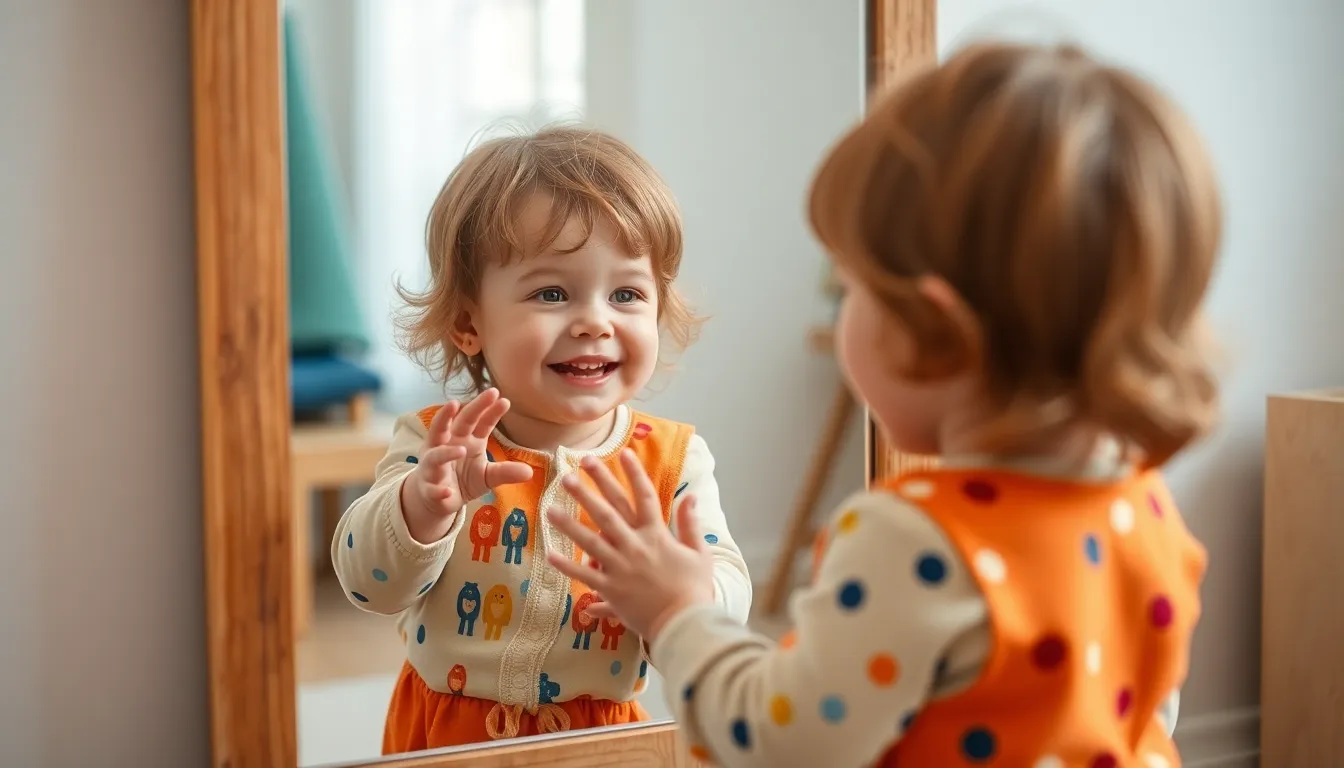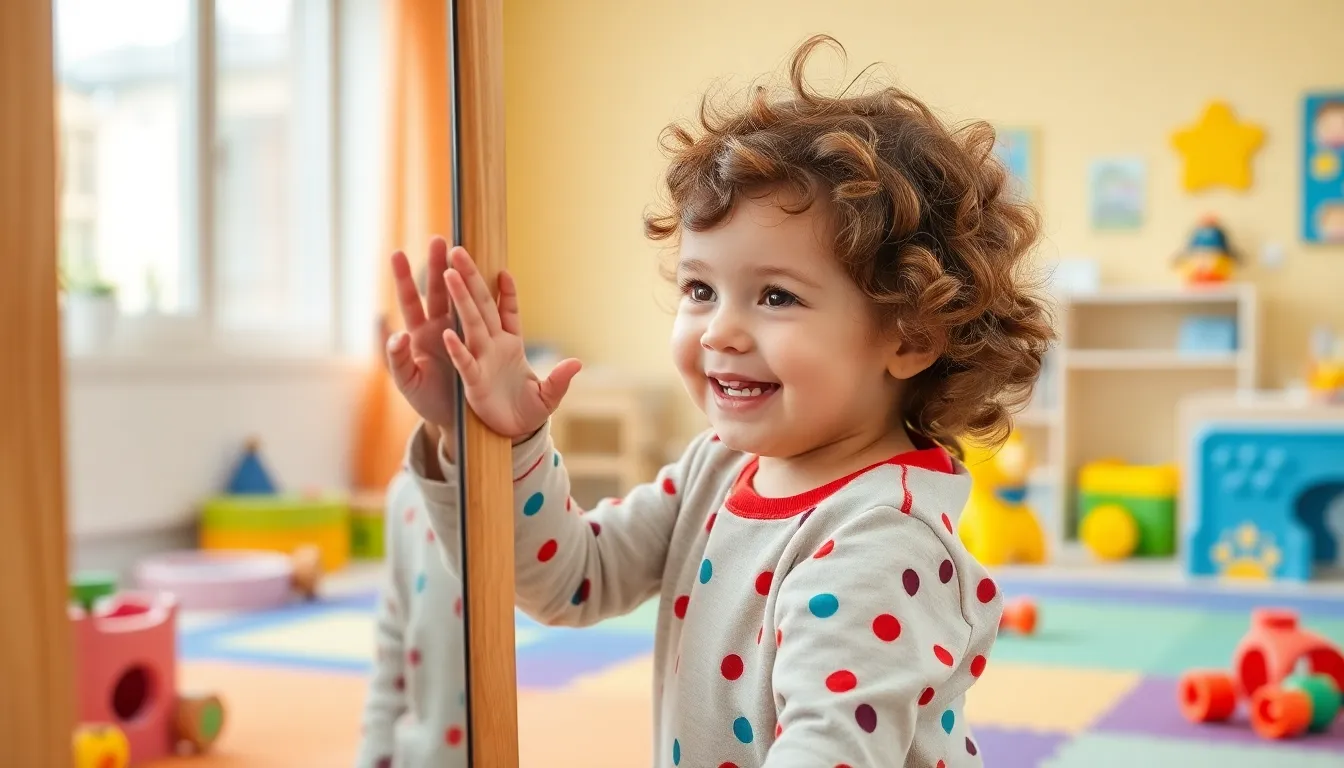Table of Contents
ToggleIn the world of Montessori education, mirrors aren’t just for checking your hair before heading out the door. They’re magical tools that spark curiosity and foster independence in young minds. Imagine a child gazing into a mirror, discovering their own reflection and the possibilities that come with it. It’s like having a mini-window to their own universe, where self-exploration reigns supreme.
Montessori mirrors come in various shapes and sizes, designed to suit little ones perfectly. They encourage movement, promote self-awareness, and even help with motor skills—all while adding a splash of fun to any learning environment. So, if you’re ready to turn playtime into a captivating adventure of self-discovery, a Montessori mirror might just be the secret ingredient you’ve been searching for. Who knew a simple reflection could lead to such profound growth?
Overview of Montessori Mirrors
Montessori mirrors play a crucial role in early childhood education. They promote exploration and self-recognition among children. By observing their reflections, kids develop self-awareness and an understanding of their bodies. Through this interaction, they gain confidence and encourage independent play.
These mirrors often come in various shapes and sizes. A full-length mirror allows toddlers to see their entire reflection, while smaller tabletop options can be used for more focused activities. Specific designs cater to different age groups, helping children engage meaningfully with themselves and their environment.
Self-discovery occurs when children explore facial expressions and movements. Children imitate actions they see, enhancing their motor skills and coordination. Observing themselves in a mirror fosters curiosity, leading to deeper learning experiences.
Incorporating Montessori mirrors into learning spaces is effective for encouraging independence. Children can practice self-care routines like brushing hair or dressing. Engaging with their reflections enables them to learn and develop problem-solving skills, as they discover what actions create specific responses.
Using mirrors in play supports social interaction as well. Children can engage in cooperative games, reinforcing social skills. By sharing mirrors, they learn to communicate, collaborate, and respect each other’s space. The presence of mirrors transforms ordinary play into an enriching experience.
Selecting the right Montessori mirror involves considering safety and quality. Non-toxic materials ensure a safe environment for children. Choosing shatterproof glass or acrylic reduces risks related to breakage. Investing in durable mirrors leads to lasting benefits in a child’s educational journey.
Benefits of Montessori Mirrors

Montessori mirrors offer numerous advantages for children’s development and learning experiences. They serve as vital tools that enhance self-awareness and foster independence.
Enhancing Self-Discovery
Montessori mirrors encourage children to explore their reflections, promoting self-recognition. Observing themselves helps in understanding their emotions and facial expressions. Children gain insights into their movements, leading to increased body awareness. This visual feedback aids in recognizing different physical abilities, boosting confidence. Playing in front of a mirror can also inspire creativity as children engage in imaginative role-play. Engaging with their reflection allows for experimentation, helping them learn about cause and effect.
Promoting Independent Play
Montessori mirrors facilitate independent play by giving children the opportunity to explore at their own pace. Children can engage without adult intervention, fostering autonomy. They often invent games or activities inspired by their reflection, which nurtures decision-making skills. This self-directed play enhances problem-solving abilities, as children learn to navigate interactions with their images. In addition, mirrors can create a safe space, encouraging children to try new movements, which builds motor skills. Independent engagement leads to a richer, more fulfilling play experience overall.
Types of Montessori Mirrors
Montessori mirrors come in various types, each serving unique purposes in child development. Understanding these options can help in selecting the right one for different learning environments.
Wall-Mounted Mirrors
Wall-mounted mirrors provide a stable and safe option for toddlers and preschoolers. These mirrors encourage children to explore their bodies and expressions without fear of tipping over. Positioning these mirrors at a child’s eye level promotes independence as they can easily observe their movements and engage in pretend play. Additionally, wall-mounted mirrors are ideal for space-saving setups in classrooms or play areas, allowing multiple children to utilize them simultaneously. The fixed nature ensures durability, making them a long-term addition to any learning environment.
Portable Mirrors
Portable mirrors offer versatility and convenience for various activities. Children can easily move these mirrors in and out of play areas, enhancing creativity in different settings. This flexibility supports independent exploration, allowing children to engage with reflections in various contexts. Portable options often come in lightweight frames, making it simple for toddlers to carry. As they observe their reflections while on the go, children develop a deeper understanding of movement and expression, promoting active play. Various designs are available, catering to the unique interests of children while encouraging interaction and self-discovery.
How to Incorporate Montessori Mirrors at Home
Incorporating Montessori mirrors at home enhances children’s self-awareness and encourages independent play. Proper placement and engaging activities ensure their effective use.
Placement Tips
Position mirrors at child-friendly heights, allowing toddlers and preschoolers to see themselves easily. Wall-mounted mirrors should be placed at eye level to promote exploration during playtime. Creating a designated area for mirror use encourages focused interaction. Ensure that the mirror’s surroundings remain safe and clutter-free to prevent accidents. Opt for more than one mirror in various rooms—bathrooms and playrooms are great options. Always prioritize shatterproof glass to enhance safety while maximizing engagement.
Activities to Encourage Use
Playful activities can enhance children’s exploration of mirrors. Encourage babies to practice tummy time in front of a mirror, stimulating their motor skills. Organize fun games like “mirror, mirror,” where children mimic facial expressions or movements. Parents can incorporate storytelling, using mirrors to illustrate characters and emotions. Arrange obstacle courses that include mirrors, allowing children to navigate while maintaining focus. Frequent interactions with mirrors cultivate creativity, boost confidence, and enhance problem-solving skills through self-discovery.
Montessori mirrors serve as invaluable tools in early childhood education. They not only enhance self-awareness but also encourage independence and creativity in young children. By engaging with their reflections, kids develop essential motor skills and confidence while exploring their emotions and movements.
Incorporating these mirrors into playtime transforms ordinary moments into enriching learning experiences. With the right selection and positioning, Montessori mirrors can create safe environments that promote exploration and social interaction. Ultimately, they play a crucial role in fostering a child’s growth and development, making learning both enjoyable and impactful.





